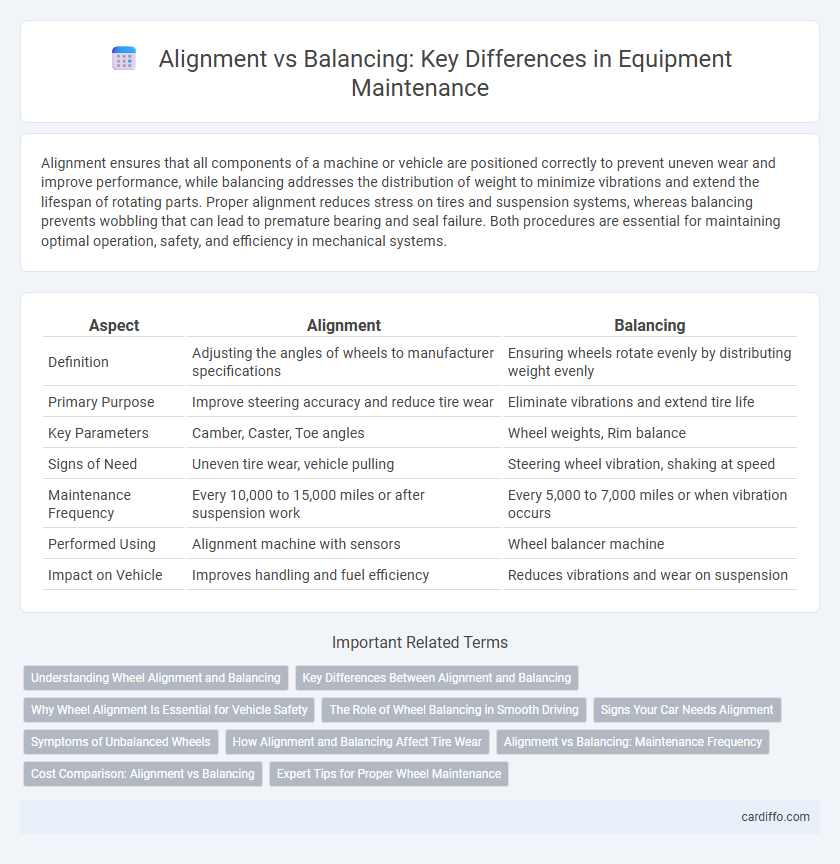Alignment ensures that all components of a machine or vehicle are positioned correctly to prevent uneven wear and improve performance, while balancing addresses the distribution of weight to minimize vibrations and extend the lifespan of rotating parts. Proper alignment reduces stress on tires and suspension systems, whereas balancing prevents wobbling that can lead to premature bearing and seal failure. Both procedures are essential for maintaining optimal operation, safety, and efficiency in mechanical systems.
Table of Comparison
| Aspect | Alignment | Balancing |
|---|---|---|
| Definition | Adjusting the angles of wheels to manufacturer specifications | Ensuring wheels rotate evenly by distributing weight evenly |
| Primary Purpose | Improve steering accuracy and reduce tire wear | Eliminate vibrations and extend tire life |
| Key Parameters | Camber, Caster, Toe angles | Wheel weights, Rim balance |
| Signs of Need | Uneven tire wear, vehicle pulling | Steering wheel vibration, shaking at speed |
| Maintenance Frequency | Every 10,000 to 15,000 miles or after suspension work | Every 5,000 to 7,000 miles or when vibration occurs |
| Performed Using | Alignment machine with sensors | Wheel balancer machine |
| Impact on Vehicle | Improves handling and fuel efficiency | Reduces vibrations and wear on suspension |
Understanding Wheel Alignment and Balancing
Wheel alignment ensures that the vehicle's wheels are set to the manufacturer's specifications for camber, caster, and toe angles, optimizing tire contact with the road and enhancing handling, fuel efficiency, and tire longevity. Balancing distributes the tire's weight evenly around the axle, preventing vibrations and uneven tire wear caused by imbalances. Understanding the distinction between alignment and balancing is crucial for effective vehicle maintenance, improved safety, and extending the lifespan of tires.
Key Differences Between Alignment and Balancing
Alignment corrects the angle of wheels to ensure proper contact with the road, preventing uneven tire wear and improving vehicle handling. Balancing distributes the weight of wheels and tires evenly around the axle, reducing vibrations and enhancing ride comfort. Both processes are essential for tire longevity and vehicle safety but address different aspects of wheel performance.
Why Wheel Alignment Is Essential for Vehicle Safety
Wheel alignment is essential for vehicle safety because it ensures that tires make proper contact with the road, improving handling and reducing uneven tire wear. Misaligned wheels can lead to poor steering response, increased tire stress, and compromised braking performance, all of which elevate accident risks. Proper alignment also enhances fuel efficiency and extends the lifespan of suspension components, contributing to overall vehicle reliability.
The Role of Wheel Balancing in Smooth Driving
Wheel balancing plays a critical role in smooth driving by ensuring that the weight of the wheel and tire assembly is evenly distributed around the axle. Proper balancing reduces vibrations, minimizes tire wear, and enhances vehicle stability at high speeds. Unlike wheel alignment, which adjusts the angles of wheels for optimal road contact, wheel balancing corrects weight imbalances to prevent uneven rotation and enhance ride comfort.
Signs Your Car Needs Alignment
Uneven tire wear, the vehicle pulling to one side while driving, and a crooked steering wheel when driving straight are clear signs your car needs alignment. Misalignment causes increased tire wear and poor handling, which can compromise safety and lead to costly repairs. Regular alignment checks improve tire lifespan, steering precision, and overall vehicle stability.
Symptoms of Unbalanced Wheels
Unbalanced wheels cause vibrations in the steering wheel, floorboard, or seat at higher speeds, often leading to uneven tire wear and reduced fuel efficiency. Symptoms include noticeable shaking during acceleration and irregular tread wear patterns, which can compromise vehicle handling and safety. Addressing wheel imbalance promptly helps maintain smooth driving conditions and prolong tire lifespan.
How Alignment and Balancing Affect Tire Wear
Proper wheel alignment ensures that tires maintain the correct angle relative to the road, preventing uneven tire wear caused by misalignment such as camber, toe, or caster errors. Balancing distributes the tire's weight evenly around the axle, reducing vibrations and minimizing tread wear from uneven pressure points. Neglecting either alignment or balancing accelerates tire degradation, leading to premature replacements and compromised vehicle handling.
Alignment vs Balancing: Maintenance Frequency
Alignment requires more frequent maintenance checks, typically every 5,000 to 10,000 miles, to ensure the wheels are correctly angled and prevent uneven tire wear. Balancing is usually performed less often, around every 6,000 to 8,000 miles or when vibrations are detected, as it corrects tire weight distribution for smooth driving. Regular wheel alignment maintains steering precision, while balancing primarily minimizes vibration and enhances tire longevity.
Cost Comparison: Alignment vs Balancing
Alignment typically involves lower labor costs and fewer parts, making it more affordable than balancing, which requires specialized equipment and additional weights. Balancing costs can escalate due to machine downtime and precision calibration needed to prevent vibration and uneven tire wear. Choosing alignment over balancing often reduces immediate expenses, but neglecting balancing may lead to higher long-term maintenance costs.
Expert Tips for Proper Wheel Maintenance
Proper wheel maintenance requires distinguishing between alignment and balancing to ensure optimal vehicle performance and tire longevity. Wheel alignment adjusts the angles of the wheels to the manufacturer's specifications, preventing uneven tire wear and improving handling, while wheel balancing addresses uneven weight distribution around the tire to reduce vibration and enhance ride comfort. Expert tips emphasize regular alignment checks every 10,000 miles and balancing during every tire change or after repair to maintain safety and performance.
Alignment vs Balancing Infographic

 cardiffo.com
cardiffo.com